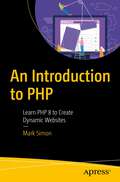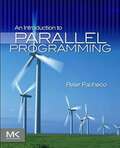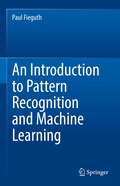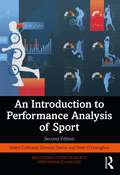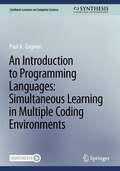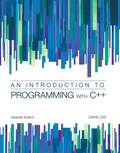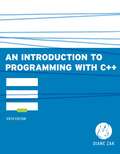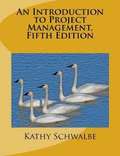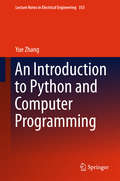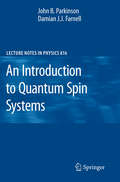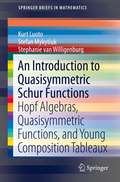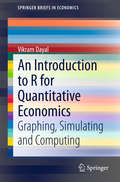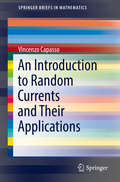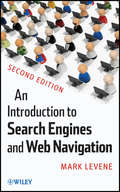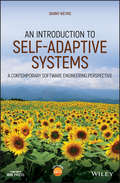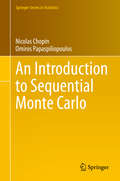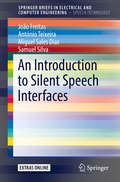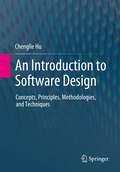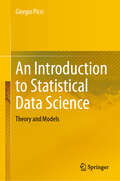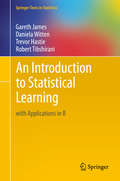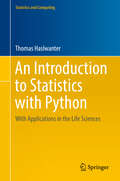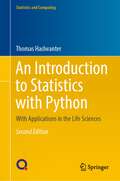- Table View
- List View
An Introduction to PHP: Learn PHP 8 to Create Dynamic Websites
by Mark SimonUse PHP to enhance your web pages. This book shows you how PHP programming works, and how to write and organize PHP code. The book starts with steps to download and install a setup for a sample website that will form the basis for upcoming chapters. You start by writing PHP code and learn how to mix it with HTML and manage the code. From there, you will learn about dynamic content, along with a deep dive into form processing and sending email. Saving uploaded data and uploading files is discussed next. You will learn how to configure your PHP project and develop a library. You will then learn how to create an image catalog and manage data on your web page. By the end of the book, you will understand how to work with cookies, sessions, and logging in, followed by an example of creating a simple blog that reiterates the concepts developed in the previous chapters.After reading this book, you will be able to configure, create, and manage your dynamic website.What Will You LearnKnow the basics of programming with the PHP languageUse PHP to generate dynamic web pagesWork with SQL databasesWork with forms to upload text data and binary filesUse tips and tricks to write clean and maintainable codeWho This Book Is ForWeb developers and students learning to develop and maintain PHP code on their website
An Introduction to Parallel Programming
by Peter PachecoAn Introduction to Parallel Programming by Pacheco, Peter
An Introduction to Pattern Recognition and Machine Learning
by Paul FieguthThe domains of Pattern Recognition and Machine Learning have experienced exceptional interest and growth, however the overwhelming number of methods and applications can make the fields seem bewildering. This text offers an accessible and conceptually rich introduction, a solid mathematical development emphasizing simplicity and intuition. Students beginning to explore pattern recognition do not need a suite of mathematically advanced methods or complicated computational libraries to understand and appreciate pattern recognition; rather the fundamental concepts and insights, eminently teachable at the undergraduate level, motivate this text. This book provides methods of analysis that the reader can realistically undertake on their own, supported by real-world examples, case-studies, and worked numerical / computational studies.
An Introduction to Performance Analysis of Sport (Routledge Studies in Sports Performance Analysis)
by Peter O'Donoghue Adam Cullinane Gemma DaviesPerformance analysis has become an essential tool for coaches, athletes, sports organisations and academic researchers. Collecting and interpreting performance data enables coaches to improve their training programmes, athletes to make better tactical decisions, sports organisations to manage teams more effectively and researchers to develop a better understanding of sports performance. This fully revised new edition is an essential introduction to the fundamental principles of performance analysis of sport and how to develop and operate performance analysis systems.Containing worked examples from real sporting events as well as new content examining innovations in determining what to analyse, advances in feedback technology, performance profiles, principles for delivering feedback and telestration within video sequences, An Introduction to Performance Analysis of Sport reviews the different types of data and information that performance analysis can generate and explains how to test for reliability.This cutting-edge book presents a step-by-step guide to developing both manual and computerised analysis systems and writing up and presenting findings from performance analysis programmes. Representing the most up-to-date, concise and engaging introduction to sports performance analysis, this book is an ideal course text for all introductory performance analysis courses, as well as an invaluable primer for coaches and practitioners in sport.
An Introduction to Programming Languages: Simultaneous Learning in Multiple Coding Environments (Synthesis Lectures on Computer Science)
by Paul A. GagniucAfter a short introduction on the history of programming languages, this book provides step-by-step examples that are mirrored in seven programming languages, including C#, C++, Java, JavaScript, PERL, PHP, Python, Ruby, VB, and VBA. This mirrored approach for each of the examples represents the main feature of the book with the goal of gaining a better understanding of the advantages and disadvantages of programming and scripting languages. This approach also allows readers to learn the mechanics of short implementations and the algorithms involved, no matter what technology and programs are used in the future. Based on the growing need for programmers to be proficient across languages, the book is designed in such a way that no prior training or exposure to the programming languages is needed by readers.
An Introduction to Programming Using Microsoft Visual Basic .net
by Beth Brown Bruce PresleyAn Introduction to Programming Using Microsoft Visual Basic .NET is written for a one-term or two-term course. No previous programming experience is required or assumed. It is the goal of this text to provide students the best possible introduction to programming using Visual Basic .NET, whether they will continue on to more advanced computer science courses or end their programming education with this introductory course.
An Introduction to Programming Using Microsoft Visual Basic® 2010
by Jan MarrelliAn Introduction to Programming Using Visual Basic 2010 emphasizes good problem-solving and programming skills in a clear, easy-to-understand format. Object-oriented programming concepts are integrated throughout the text and each chapter explains the use of Visual Basic controls. Example Applications throughout the text demonstrate important programming concepts and are complete with runs that show outputs. Written and classroom tested by experienced programming teachers, our Visual Basic 2010 text describes many of the practical applications of Visual Basic and includes: Core programming concepts; Using built-in classes; Color, sound, and graphics; Business functions; Creating classes and understanding instantiation, encapsulation, inheritance, and polymorph ism; Manipulating files; MDI applications; Databases and Web Programming. An Introduction to Programming Using Visual Basic 2010 is an excellent text for an introductory programming course in a sequence leading to Java. - Publisher.
An Introduction to Programming with C++ (6th Edition)
by Diane ZakAn Introduction to Programming with C++, Sixth Edition is the latest C++ offering from Diane Zak. This book is distinct from other textbooks because of its unique approach, which motivates students by demonstrating why they need to learn the concepts and skills presented. Each chapter contains Mini-Quizzes, Labs, and Try This features to help readers practice and absorb the content as they go along. This edition also includes completely new applications and exercises, more IPO charts and flowcharts, and a brand new interior design.
An Introduction to Project Management
by Kathy SchwalbeThe fifth edition of An Introduction to Project Management provides a separate chapter for planning integration and scope management and for planning time and cost management. Additional examples are provided for creating work breakdown structures and schedules. It also includes information on Basecamp, a free web-based project management tool, along with a user guide (replaces AtTask in Appendix B). In addition to updating many references and examples, this edition continues to include several popular features: - Follows the Project Management Institute's PMBOK® Guide, Fifth Edition (2013) - Has chapters for each process group and a comprehensive case study to illustrate applying tools and techniques throughout the project life cycle - Includes a Guide for using Microsoft Project 2013 - Provides a free trial of MatchWare's MindView Business software (www.matchware.com/intropm), a tool for creating mind maps, Gantt charts, and other project documents - Uses real-world examples and references, including opening cases and case wrap-ups, examples of what went right, what went wrong, media snapshots, best practices, and video highlights in each chapter - End of chapter materials include chapter summaries, quick quizzes, discussion questions, and exercises, with case studies provided in Appendix C -Comprehensive, secure instructor site available with lecture slides, solution files, test banks, etc. -Free Web site includes over fifty template files, online quizzes and games, data files for Project 2013, links to sites mentioned in the text, and much more.
An Introduction to Python and Computer Programming (Lecture Notes in Electrical Engineering #353)
by Yue ZhangThis book introduces Python programming language and fundamental concepts in algorithms and computing. Its target audience includes students and engineers with little or no background in programming, who need to master a practical programming language and learn the basic thinking in computer science/programming. The main contents come from lecture notes for engineering students from all disciplines, and has received high ratings. Its materials and ordering have been adjusted repeatedly according to classroom reception. Compared to alternative textbooks in the market, this book introduces the underlying Python implementation of number, string, list, tuple, dict, function, class, instance and module objects in a consistent and easy-to-understand way, making assignment, function definition, function call, mutability and binding environments understandable inside-out. By giving the abstraction of implementation mechanisms, this book builds a solid understanding of the Python programming language.
An Introduction to Quantum Spin Systems (Lecture Notes in Physics #816)
by Damian J. Farnell John B. ParkinsonThe topic of lattice quantum spin systems is a fascinating and by now well-established branch of theoretical physics. However, many important questions remain to be answered. Their intrinsically quantum mechanical nature and the large (usually effectively infinite) number of spins in macroscopic materials often leads to unexpected or counter-intuitive results and insights. Spin systems are not only the basic models for a whole host of magnetic materials but they are also important as prototypical models of quantum systems. Low dimensional systems (as treated in this primer), in 2D and especially 1D, have been particularly fruitful because their simplicity has enabled exact solutions to be determined in many cases. These exact solutions contain many highly nontrivial features. This book was inspired by a set of lectures on quantum spin systems and it is set at a level of practical detail that is missing in other textbooks in the area. It will guide the reader through the foundations of the field. In particular, the solutions of the Heisenberg and XY models at zero temperature using the Bethe Ansatz and the Jordan-Wigner transformation are covered in some detail. The use of approximate methods, both theoretical and numerical, to tackle more advanced topics is considered. The final chapter describes some very recent applications of approximate methods in order to show some of the directions in which the study of these systems is currently developing.
An Introduction to Quasisymmetric Schur Functions: Hopf Algebras, Quasisymmetric Functions, and Young Composition Tableaux (SpringerBriefs in Mathematics)
by Kurt Luoto Stephanie Van Willigenburg Stefan MykytiukAn Introduction to Quasisymmetric Schur Functions is aimed at researchers and graduate students in algebraic combinatorics. This book introduces readers to the algebra of quasisymmetric functions and its fundamental theory. Results and relevant new contributions are included which pertains to the dynamic new basis of quasisymmetric Schur functions. A state-of-the-art summary is included with respect to an exciting new basis of algebra, which is the basis of quasisymmetric Schur functions, whose combinatorics is analogous to that of the renowned Schur functions.
An Introduction to R for Quantitative Economics: Graphing, Simulating and Computing (SpringerBriefs in Economics)
by Vikram DayalThis book gives an introduction to R to build up graphing, simulating and computing skills to enable one to see theoretical and statistical models in economics in a unified way. The great advantage of R is that it is free, extremely flexible and extensible. The book addresses the specific needs of economists, and helps them move up the R learning curve. It covers some mathematical topics such as, graphing the Cobb-Douglas function, using R to study the Solow growth model, in addition to statistical topics, from drawing statistical graphs to doing linear and logistic regression. It uses data that can be downloaded from the internet, and which is also available in different R packages. With some treatment of basic econometrics, the book discusses quantitative economics broadly and simply, looking at models in the light of data. Students of economics or economists keen to learn how to use R would find this book very useful.
An Introduction to Random Currents and Their Applications (SpringerBriefs in Mathematics)
by Vincenzo CapassoThis book introduces random currents by presenting underlying mathematical methods necessary for applications. The theory of currents is an advanced topic in geometric measure theory that extends distribution to linear functionals within the space of differential forms of any order. Methods to extend random distributions to random currents are introduced and analyzed in this book. Beginning with an overview of mathematical aspects of the theory of currents, this book moves on to examine applications in medicine, material science, and image analysis. Applied researchers will find the practical modern mathematical methods along with the detailed appendix useful to stimulate new applications and research.
An Introduction to Search Engines and Web Navigation
by Mark LeveneThis book is a second edition, updated and expanded to explain the technologies that help us find information on the web. Search engines and web navigation tools have become ubiquitous in our day to day use of the web as an information source, a tool for commercial transactions and a social computing tool. Moreover, through the mobile web we have access to the web's services when we are on the move. This book demystifies the tools that we use when interacting with the web, and gives the reader a detailed overview of where we are and where we are going in terms of search engine and web navigation technologies.
An Introduction to Self-adaptive Systems: A Contemporary Software Engineering Perspective (Wiley - IEEE)
by Danny WeynsA concise and practical introduction to the foundations and engineering principles of self-adaptation Though it has recently gained significant momentum, the topic of self-adaptation remains largely under-addressed in academic and technical literature. This book changes that. Using a systematic and holistic approach, An Introduction to Self-adaptive Systems: A Contemporary Software Engineering Perspective provides readers with an accessible set of basic principles, engineering foundations, and applications of self-adaptation in software-intensive systems. It places self-adaptation in the context of techniques like uncertainty management, feedback control, online reasoning, and machine learning while acknowledging the growing consensus in the software engineering community that self-adaptation will be a crucial enabling feature in tackling the challenges of new, emerging, and future systems. The author combines cutting-edge technical research with basic principles and real-world insights to create a practical and strategically effective guide to self-adaptation. He includes features such as: An analysis of the foundational engineering principles and applications of self-adaptation in different domains, including the Internet-of-Things, cloud computing, and cyber-physical systems End-of-chapter exercises at four different levels of complexity and difficulty An accompanying author-hosted website with slides, selected exercises and solutions, models, and code Perfect for researchers, students, teachers, industry leaders, and practitioners in fields that directly or peripherally involve software engineering, as well as those in academia involved in a class on self-adaptivity, this book belongs on the shelves of anyone with an interest in the future of software and its engineering.
An Introduction to Sequential Monte Carlo (Springer Series in Statistics)
by Nicolas Chopin Omiros PapaspiliopoulosThis book provides a general introduction to Sequential Monte Carlo (SMC) methods, also known as particle filters. These methods have become a staple for the sequential analysis of data in such diverse fields as signal processing, epidemiology, machine learning, population ecology, quantitative finance, and robotics.The coverage is comprehensive, ranging from the underlying theory to computational implementation, methodology, and diverse applications in various areas of science. This is achieved by describing SMC algorithms as particular cases of a general framework, which involves concepts such as Feynman-Kac distributions, and tools such as importance sampling and resampling. This general framework is used consistently throughout the book.Extensive coverage is provided on sequential learning (filtering, smoothing) of state-space (hidden Markov) models, as this remains an important application of SMC methods. More recent applications, such as parameter estimation of these models (through e.g. particle Markov chain Monte Carlo techniques) and the simulation of challenging probability distributions (in e.g. Bayesian inference or rare-event problems), are also discussed.The book may be used either as a graduate text on Sequential Monte Carlo methods and state-space modeling, or as a general reference work on the area. Each chapter includes a set of exercises for self-study, a comprehensive bibliography, and a “Python corner,” which discusses the practical implementation of the methods covered. In addition, the book comes with an open source Python library, which implements all the algorithms described in the book, and contains all the programs that were used to perform the numerical experiments.
An Introduction to Silent Speech Interfaces (SpringerBriefs in Speech Technology)
by João Freitas António Teixeira Miguel Sales Dias Samuel SilvaThis book provides a broad and comprehensive overview of the existing technical approaches in the area of silent speech interfaces (SSI), both in theory and in application. Each technique is described in the context of the human speech production process, allowing the reader to clearly understand the principles behind SSI in general and across different methods. Additionally, the book explores the combined use of different data sources, collected from various sensors, in order to tackle the limitations of simpler SSI approaches, addressing current challenges of this field. The book also provides information about existing SSI applications, resources and a simple tutorial on how to build an SSI.
An Introduction to Software Design: Concepts, Principles, Methodologies, and Techniques
by Chenglie HuThis textbook provides a balanced coverage on software design, including design principles, methodologies, and techniques in contexts of designing modules of small and larger sizes with a multi-paradigm viewpoint emphasizing design trade-off. Commonly used design diagrams and patterns are also covered in terms of the design ideas behind and their effective use. The book also explores what (software) design thinking is, the role it plays in a design process, and ways to promote it. Despite object orientation being still the center of attention, there is a strong promotion throughout the book that software design should consider all appropriate design paradigms and methodologies.The book is organized in 10 chapters. Chapter 1 is dedicated to an exploration of what software design may be and entail. Next, chapters 2 and 3 are designed to help readers better understand object orientation, and the essentials of object-oriented design. Chapter 4 is then dedicated to the design of methods, while chapters 5, 6, and 8 respectively include topics about the design of objects, modeling with the Unified Modeling Language, and the use of design patterns. Larger software elements are often directly responsible for the formation of software architecture, thus chapter 7 covers four kinds of larger software elements: libraries, components, frameworks, and microservices, and their architectural implications. Chapter 9 finally brings the presentation of software design to an end with a coverage on software architecture focusing on software architectural views. Case studies are important in learning how to design software, hence chapter 10 then gathers some small design case studies that can be used in earlier chapters as appropriate. These case studies can be extended in different ways to provide additional design opportunities.This textbook book is intended for a junior level undergraduate course on software design, yet the depth of the book makes it also appropriate for a design course at beginning graduate level. Professionals may also find the book useful in their professional development.
An Introduction to Statistical Data Science: Theory and Models
by Giorgio PicciThis graduate textbook on the statistical approach to data science describes the basic ideas, scientific principles and common techniques for the extraction of mathematical models from observed data. Aimed at young scientists, and motivated by their scientific prospects, it provides first principle derivations of various algorithms and procedures, thereby supplying a solid background for their future specialization to diverse fields and applications. The beginning of the book presents the basics of statistical science, with an exposition on linear models. This is followed by an analysis of some numerical aspects and various regularization techniques, including LASSO, which are particularly important for large scale problems. Decision problems are studied both from the classical hypothesis testing perspective and, particularly, from a modern support-vector perspective, in the linear and non-linear context alike. Underlying the book is the Bayesian approach and the Bayesian interpretation of various algorithms and procedures. This is the key to principal components analysis and canonical correlation analysis, which are explained in detail. Following a chapter on nonlinear inference, including material on neural networks, the book concludes with a discussion on time series analysis and estimating their dynamic models. Featuring examples and exercises partially motivated by engineering applications, this book is intended for graduate students in applied mathematics and engineering with a general background in probability and linear algebra.
An Introduction to Statistical Learning: with Applications in R (Springer Texts in Statistics #103)
by Trevor Hastie Gareth James Robert Tibshirani Daniela WittenAn Introduction to Statistical Learning provides an accessible overview of the field of statistical learning, an essential toolset for making sense of the vast and complex data sets that have emerged in fields ranging from biology to finance to marketing to astrophysics in the past twenty years. This book presents some of the most important modeling and prediction techniques, along with relevant applications. Topics include linear regression, classification, resampling methods, shrinkage approaches, tree-based methods, support vector machines, clustering, and more. Color graphics and real-world examples are used to illustrate the methods presented. Since the goal of this textbook is to facilitate the use of these statistical learning techniques by practitioners in science, industry, and other fields, each chapter contains a tutorial on implementing the analyses and methods presented in R, an extremely popular open source statistical software platform. Two of the authors co-wrote The Elements of Statistical Learning (Hastie, Tibshirani and Friedman, 2nd edition 2009), a popular reference book for statistics and machine learning researchers. An Introduction to Statistical Learning covers many of the same topics, but at a level accessible to a much broader audience. This book is targeted at statisticians and non-statisticians alike who wish to use cutting-edge statistical learning techniques to analyze their data. The text assumes only a previous course in linear regression and no knowledge of matrix algebra.
An Introduction to Statistics with Python: With Applications in the Life Sciences (Statistics and Computing)
by Thomas HaslwanterThis textbook provides anintroduction to the free software Python and its use for statistical dataanalysis. It covers common statistical tests for continuous, discrete andcategorical data, as well as linear regression analysis and topics from survivalanalysis and Bayesian statistics. Working code and data for Python solutionsfor each test, together with easy-to-follow Python examples, can be reproducedby the reader and reinforce their immediate understanding of the topic. Withrecent advances in the Python ecosystem, Python has become a popular languagefor scientific computing, offering a powerful environment for statistical dataanalysis and an interesting alternative to R. The book is intended for masterand PhD students, mainly from the life and medical sciences, with a basicknowledge of statistics. As it also provides some statistics background, thebook can be used by anyone who wants to perform a statistical dataanalysis.
An Introduction to Statistics with Python: With Applications in the Life Sciences (Statistics and Computing)
by Thomas HaslwanterNow in its second edition, this textbook provides an introduction to Python and its use for statistical data analysis. It covers common statistical tests for continuous, discrete and categorical data, as well as linear regression analysis and topics from survival analysis and Bayesian statistics.For this new edition, the introductory chapters on Python, data input and visualization have been reworked and updated. The chapter on experimental design has been expanded, and programs for the determination of confidence intervals commonly used in quality control have been introduced. The book also features a new chapter on finding patterns in data, including time series. A new appendix describes useful programming tools, such as testing tools, code repositories, and GUIs.The provided working code for Python solutions, together with easy-to-follow examples, will reinforce the reader’s immediate understanding of the topic. Accompanying data sets and Python programs are also available online. With recent advances in the Python ecosystem, Python has become a popular language for scientific computing, offering a powerful environment for statistical data analysis.With examples drawn mainly from the life and medical sciences, this book is intended primarily for masters and PhD students. As it provides the required statistics background, the book can also be used by anyone who wants to perform a statistical data analysis.
An Introduction to Support Vector Machines: and other kernel-based learning methods
by John Shawe-Taylor Nello CristianiniThis is the first comprehensive introduction to Support Vector Machines (SVMs), a new generation learning system based on recent advances in statistical learning theory. Students will find the book both stimulating and accessible, while practitioners will be guided smoothly through the material required for a good grasp of the theory and its applications. The concepts are introduced gradually in accessible and self-contained stages, while the presentation is rigorous and thorough. Pointers to relevant literature and web sites containing software make it an ideal starting point for further study.
